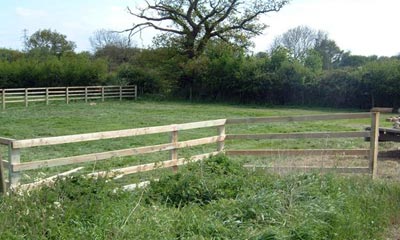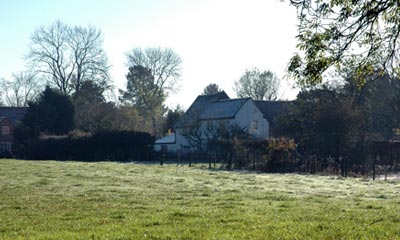Self Build Guide - Building Regulations in UK
Building Regulations in UK are a set of minimum requirements designed to secure the health, safety and welfare of people in and around buildings and to conserve fuel and energy in England and Wales. They are made by the Secretary of State under Powers given by Section 1 of The Building Act 1984.

Although the Approved Documents give guidance as how to meet the requirements of the Regulations, the requirements are set out in the following Parts:-
There are two methods of applying for Building Regulations Approval:-
- A "Full Plans Approval" submission, and
- A "Building Notice" application.
If the use of the building is a "designated use" under the Fire Precautions Act 1971, the application method must be a "Full Plans" submission. This is to allow Building Control to consult the Fire Brigade to see if they have any comments on the adequacy of the Buildings proposed Means of Escape in the Event of Fire. Approved plans are valid for at least 3 years. If something is clearly shown on the approved plans then Building Control may not subsequently object to what is shown even if the Regulations change and become more onerous.
In both cases Building Control will carry out site inspections at various stages. The total fee is the same which ever method is chosen.
Part A Structural stability. So that buildings do not collapse there are requirements:-
(1) that all structural elements of a building can safely carry the loads expected to be placed on them;
(2) that foundations be adequate for any movement of the ground through for example trees, etc;
(3) that large buildings are sufficiently robust that an explosion would not cause excessive collapse.
Part B Fire Safety. The Regulations consider 5 aspects of fire safety in the construction of buildings. Other aspects such as the management of a premises may be dealt with under different legislation. The 5 aspects are:-
(1) that sufficient provisions are made in design of the building that in the event of fire the occupants can escape to a place of safety by their own efforts;
(2) that the internal linings of a building do not support a rapid spread of fire;
(3) that the structure of the building should not collapse prematurely and should slow the spread of fire through the building and in unseen cavities and voids by providing fire resisting walls and partitions where necessary;
(4) that the spread of fire between buildings be discouraged by spacing them apart sufficiently and controlling the number and size of openings on boundaries;
(5) that the building is designed in such a way to aid the fire brigade fight fire and effect rescue of persons caught in a fire.

Part C Site preparation and resistance to moisture. There are four requirements to this part:-
(1) that before building works start all vegetation and topsoil be removed;
(2) that any contaminated ground is either treated or neutralized or removed before a building is erected;
(3) that subsoil drainage is provided to waterlogged sites;
(4) that the roof, walls, and floor be adequately weatherproofed against damp and rain penetration.
Part D Toxic substances. Cavity Insulation.
This part requires walls to be constructed in such a way that cavity fill fumes are prevented from penetrating the building.
Part E Resistance to passage of sound. This part has three main aspects:-
(1) that walls of dwellings have reasonable resistance to the passage of airborne sound;
(2) that floors and stairs in flats have reasonable resistance to the passage of airborne sound from below;
(3) that floors in flats have reasonable resistance to the passage of impact sound from above.
Part F Ventilation. There are two aspects considered by this part:-
(1) Adequate ventilation must be provided to kitchens, bath and shower rooms, sanitary accommodation and to other habitable rooms both domestic and non-domestic;
(2) Roofs need to be well vented or designed to prevent moist air causing condensation damage.
Part G Hygiene. There are three aspects included in this part:-
(1) Buildings are required to have satisfactory sanitary conveniences and washing facilities;
(2) All dwellings are required to have a fixed bath or shower with hot and cold water;
(3) Unvented hot water systems over a certain size are required to have safety provisions to prevent explosion.
Part H Drainage and Waste Disposal. There are four aspects of this part:-
(1) New drains taking foul water from buildings are required to discharge to a foul water sewer, or other suitable outfall, and be watertight, and accessible for cleaning;
(2) Where no public sewer is available adequately designed holding tanks or sewage treatment plants may be used instead;
(3) New drains taking rainwater from roofs of buildings are required to be watertight, accessible for cleaning and discharge to a suitable surface water sewer or ditch, soakaway, or watercourse where no sewer available;
(4) Adequately sized storage facilities are required to be provided for refuse collection reasonably close to buildings.
Part J Heat producing appliances. There are three main aspects to this part:-
(1) Heat producing appliances must be provided with an adequate supply of fresh air to prevent carbon monoxide poisoning of a building's occupants from inadequate combustion;
(2) Chimneys and flues need to be adequately designed for safe discharge of smoke and other products of combustion to the outside air;
(3) Fireplaces and heat producing appliances should be designed and positioned so as to avoid the buildings structure from igniting.
Part K Stairs, ladders, ramps, guards, etc - Protection from falling, collision and impact. There are three main aspects to this part (five from 1/1/98):-
(1) To avoid accidents on stairs ladders and ramps, the physical dimensions need to be suitable for the use of the building, (see also Part B1 and M2 where other aspects have greater control);
(2) To avoid persons falling, stairwells, balconies, floors, some roofs and (from 1/1/98) light well, basement area or similar sunken area strConected to a building need to have suitable guarding of adequate design, height and strength for their location and building use;
(3) To avoid vehicles falling off buildings, car park floors, ramps and other raised areas need to have adequate vehicle barriers provided and (from 1/1/98) vehicle loading bays to have people refuges or escape stairs. (From 1/1/98)
(4) To avoid danger to people from colliding with an open window, skylight, or ventilator adequate provisions such as guarding may need to be made. (From 1/1/98)
(5) To avoid the opening and closing of powered sliding or open-upwards doors and gates falling onto any person or trapping them certain safety measures are required to be provided.
Part L Conservation of fuel and power. There are three main aspects to this part:-
(1) Roofs, walls, windows, doors and floors need to have adequate resistance to loss of heat. The amount required varies with the size and use of building and the presence of compensatory features;
(2) Sufficient controls need to be provided for occupants to be able to turn off electric lighting and for low energy lights to be used;
(3) Adequate controls are required to be provided in the use of boilers to avoid inefficient usage and waste.
Part M Access and facilities for disabled people. There are four main aspects to this part:-
(1) Buildings are to be designed to aid their use by people with a disability which limits their ability to walk, see or hear; From 25/10/99 this includes:
- Dwellings having wider corridors, passages, stairs, and internal doors in the entrance storey.
- All switches and electrical sockets in a dwelling to be positioned between 450mm and 1200mm from floor level.
- Requirements for the common areas of new flats to be easier for disabled people to access the flats. Requirements relate around suitable lifts and stairs.
(2) All new buildings (including new dwellings from 25/10/99) and some extensions to buildings (not dwelling extensions) must allow access for people with disabilities into and within buildings;
(3) Sanitary conveniences need to be provided of adequate size and fittings to facilitate their use by people with a wide range of disabilities. (From 25/10/99 new housing must have a WC that is accessible to users of wheelchairs in the entrance storey. If there is no habitable rooms in the entrance storey, however, the accessible WC could be in the principal storey.)
(4) Audience or spectator seating in theatres, auditoria, sports grounds etc are required to have suitable facilities provided for users of wheelchairs.
Part N Glazing - materials and protection. There are two main aspects in this part (four main aspects from 1/1/98):-
(1) Glazing in critical locations where people might collide with the glass should either be robust enough not to break or be constructed of safety glass or be provided with suitable guarding;
(2) Large sheets of glazing need to be made obvious so that people do not collide with the glazing. (From 1/1/98)
(3) Where non-dwelling windows, skylights and ventilators are to be openable by people controls and/or limiters are to be provided to ensure safe operation and prevent persons falling through a window. (From 1/1/98)
(4) Safe access for cleaning both sides of non-dwelling windows, skylights etc over 2.0m above ground is to be made.
The Building Regulations 1991 are made by the Secretary of State for the Environment under powers delegated by Parliament under the Building Act 1984. These Regulations are framed as basic performance standards. The level of safety and standards acceptable are set out as guidance in the Approved Documents. Compliance with the detailed guidance of the Approved Documents is evidence that the Regulations themselves have been complied with. Alternate ways of achieving the same level of safety are also acceptable.
Just because an Approved Document has not been complied with does not necessarily mean that the work is unsafe. The circumstances of each particular case are considered when an Application is made that adequate levels of safety will be achieved. The Approved Documents may be purchased from the HMSO at 49 High Holborn, London, WC1 (Telephone Orders: 0171-873-9090) or from bookshops such as The Building Bookshop, Store Street, off Tottenham Court Road, London. (Nearest tube: Goodge Street).
This flexible approach means that the Building Regulations are adaptable to allow innovative design and the variation of circumstances of each particular building.
Building Work Needing Formal Approval. Building work needs formal approval for:-
- The erection of a new building or re-erection of an existing building;
- The extension of a building;
- The "material alteration" of a building;
- The "material change of use of a building;
- The installation, alteration or extension of a controlled service or fitting to a building.
Typical Examples of Work Needing Approval:-
- Home extensions such as for a kitchen, bedroom, lounge, etc;
- Loft conversions;
- Internal structural alterations, such as the removal of a load-bearing wall or partition;
- Installation of baths, showers, WCs which involve new drainage or waste plumbing;
- Installation of new heating appliances (other than electric);
- New chimneys or flues;
- Underpinning of foundations;
- Altered openings for new windows in roofs or walls;
- Replacing roof coverings (unless exactly like for like repair);
- Installation of cavity insulation.
- Erection of new buildings that are not exempt.
Exemptions
There are certain buildings and work that are exempt from control. This is generally because they are buildings controlled by other legislation; buildings not frequented by people; Greenhouses & Agricultural Buildings; Temporary Buildings, Small Detached Buildings; or certain extensions where it would NOT be reasonable to control. It is advisable to write in to your Local Authority Building Control with details of your particular exemption claim so that you obtain a written reply agreeing the exemption. This will aid any future sale of the property.
Dangerous Buildings are controllable by the Local Authority under Sections 77 and 78 of the Building Act 1984.
This involves responding to all reported instances of dangerous walls, structures and buildings within each Local Authorities area on a 24 hour 365 days a year basis.
Refer to the relevant Local Authority Building Control during office hours or their Local Authority Emergency Switchboard, out of hours.
If the building or structure poses a potential danger to the safety of people, the Local Authrity takes the appropriate action to remove the danger. The Local Authority has powers to require the owners of buildings or structures to remedy the defects or directs their own Local Authority contractors to carry out works to make the building or structure safe. In addition, the Local Authority may provide advice on the structural condition of Buildings during fire fighting to the Fire Brigade.
(In Inner London the Legislation is under The London Building (Amendment) Act 1939)
Demolitions. Under Section 80 of the Building Act 1984 anyone carrying out demolition work is required to notify the Local Authority. The Local Authority then has six weeks to respond with appropriate notices and consultation under Sections 81 and 82 of the Act.
(Does not apply to Inner London)
"Full Plans" MEANS the submission of fully detailed plans, specifications, calculations and other supporting details to enable the Building Control Surveyor to ascertain compliance with the Building Regulations. The amount of detail depends on the size and type of building works proposed. A location plan showing where the building is located relative to neighboring streets should be included . The advantage of the "Full Plans" method of submission is:-
- 1) That the plans can be examined and approved in advance for typically 25% of the total fee;
- 2) A formal notice of approval or rejection must be issued within 5 weeks unless applicant agrees to extend this to two months;
- 3) When works start on site Building Control must be notified and the remaining part of fee is invoiced for after the first visit on site;
- 4) That a requested free satisfactory Completion Certificate will be issued on satisfactory completion of the work.
- 5) The approved plans may be built to for at least 3 years even if Regulations change.
The "Building Notice" method is most suitable where small works are to be done and so detailed plans are unnecessary. As no formal approval is given good liaison between the builder and the building control surveyor is essential to ensure that work does not have to be re-done. This method is not allowed for work on designated buildings. The submission of a marked up sketch showing the location of the building is helpful.
The "Completion Certificate" certifies that the local authority are satisified that the work complies with the relevant requirements of Schedule 1 of the Building Regulations, in so far as they have been able to ascertain after taking all reasonable steps. For this reason it is very important that they be called in to inspect the work as it progresses. In particular they are required to be notified before the commencement of work; excavations for foundations; any foundation; any damp-proof course; any concrete or other material laid over a site; drains or sewer under the control of the Building Regulations; completion of haunching of a drain; completion of backfill to a drain; final completion of building works to the satisfaction of the local authority. When property is to be sold a Completion Certificate speeds the sale process. It is then a valuable document which should be kept in a safe place.
"Designated Use" under the Fire Precautions Act 1971 are for buildings (or part) used for:- Office, Shop, Factory, Railway premises, Hotel, Boarding House, or a non-domestic workplace in a building.
Continue Reading: Why Self Build?
September 2004
